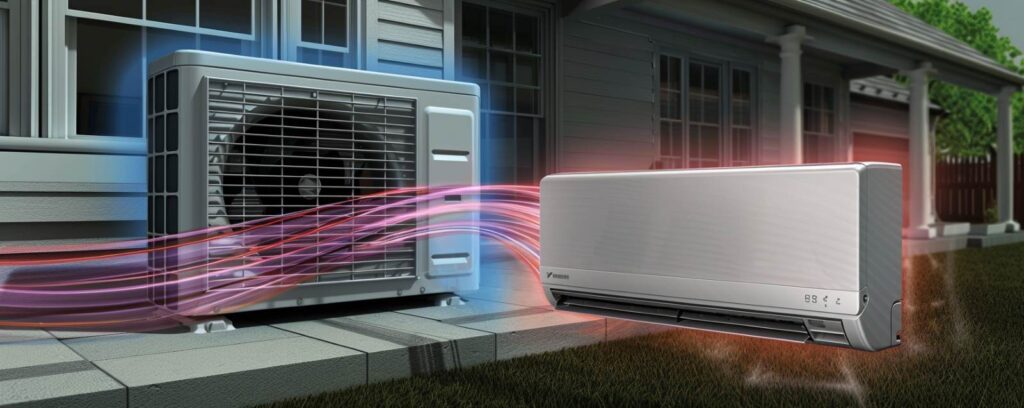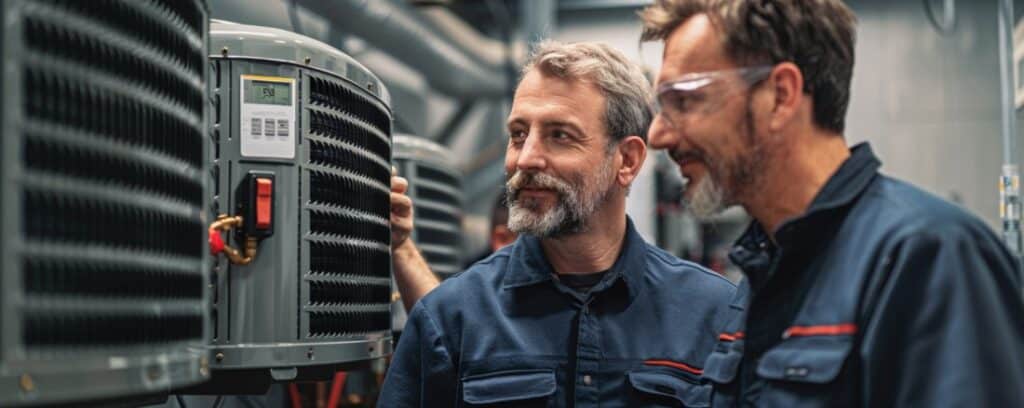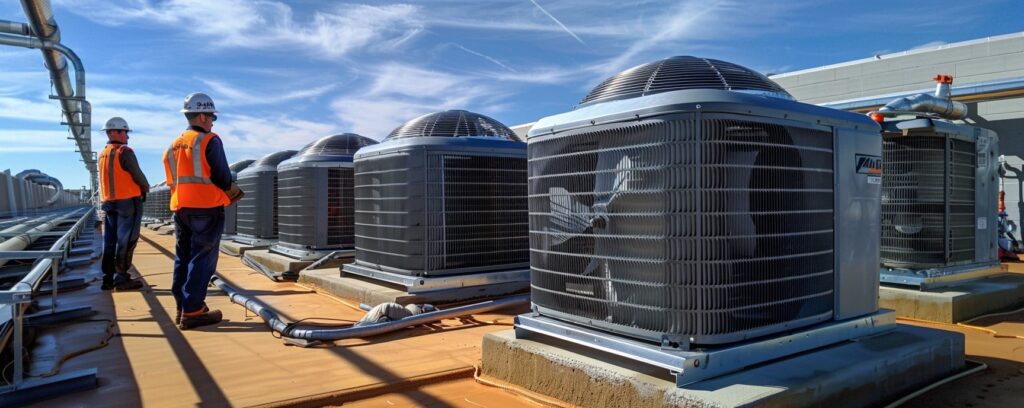- The Historical Context
- Climate Change and HVAC
- The Demand for Energy-Efficiency
- The Broader Implications
- 1. Smart Thermostats and Controls
- 2. Geothermal Heating and Cooling Systems
- 3. Variable Refrigerant Flow (VRF) Systems
- 4. Sensor-Enhanced Ventilation
- 5. UV-C Light for Air Purification
- 6. Radiant Floor Heating Systems
- 7. Ice-Powered Air Conditioning
- Reduced Energy Consumption
- Enhanced User Comfort
- The Need for Continuous Learning
- Attractive Prospects for New Entrants
- Emerging Innovations
- A Shift Towards Complete Sustainability
The significance of HVAC (Heating, Ventilation, and Air Conditioning) systems remains paramount. From ensuring comfortable living spaces in residential settings to maintaining the right environment for businesses, HVAC systems have become integral to modern life. Over the decades, as technological advancements shaped various industries, HVAC was no exception. With the development of new HVAC technology, the industry has not only evolved to meet changing demands but also paved the way for enhanced efficiency and comfort.
The trajectory of the HVAC industry’s evolution is exciting, driven by the need for smarter, more energy-efficient systems. The advent of new HVAC technology is a testament to how innovation is at the forefront of meeting global challenges such as climate change and energy consumption.
The Historical Context
From the rudimentary systems used in ancient civilizations to regulate indoor temperatures, HVAC systems have come a long way. While the basic principles might remain, the techniques, materials, and technologies have seen massive overhauls. These shifts were not just about efficiency; they encompassed user-friendliness, integration with other home systems, and sustainability.
The Rising Importance of the HVAC Industry
The HVAC industry is witnessing a transformative period, with new HVAC technology playing a pivotal role. A combination of global factors and technological advancements has placed the industry at a crucial juncture, making it more important than ever.
Climate Change and HVAC
The undeniable impact of climate change has redefined the requirements of HVAC systems. With rising global temperatures and extreme weather events, there is a pressing need for HVAC systems that can adapt to these changes, ensuring consistent indoor comfort. This has opened up avenues for new HVAC technology that is not just reactive but also proactive in addressing these challenges.
Adapting to Varied Climates
Whether it’s the sweltering heat of summer or the biting cold of winter, modern HVAC systems need to be versatile. This adaptability is a core feature of newer technologies, ensuring that no matter the external environment, the indoors remain unaffected.
The Demand for Energy-Efficiency
As global energy consumption continues to rise, there is a collective push towards more sustainable solutions. HVAC systems, traditionally significant energy consumers, are now at the forefront of this shift. New HVAC technology is paving the way for systems that consume less energy without compromising on output. This not only reduces the strain on energy grids but also translates to cost savings for consumers.
Smart Systems and Their Role
With the integration of IoT (Internet of Things) and smart technology, HVAC systems are becoming more intelligent. They can now predict user preferences, adapt to external conditions, and even communicate with other home systems to optimize energy use. This kind of intelligent automation is only possible due to the innovations in new HVAC technology.
The Broader Implications
The evolution in the HVAC industry is not just about better systems; it’s about creating a more sustainable future. With these advancements, the industry is not only catering to immediate needs but also laying the groundwork for the future—a future where technology and sustainability go hand in hand.
Highlight: 7 New HVAC Technologies
1. Smart Thermostats and Controls
The digital age has ushered in a wave of smart devices, and HVAC systems haven’t been left behind. Smart thermostats and controls represent a significant leap in new HVAC technology. Unlike traditional thermostats, these smart devices can learn from user behaviors, predict preferences, and adjust settings for optimal comfort and energy efficiency. Not only can users control them remotely via smartphones or voice commands, but these thermostats also provide feedback on energy usage, allowing for more informed decisions about heating and cooling.
Industry Impact: The integration of smart thermostats into HVAC systems introduces a higher level of automation and intelligence. This shift is making systems more user-friendly and energy-efficient, allowing providers to tap into a growing market of tech-savvy consumers who prioritize both comfort and energy savings.
2. Geothermal Heating and Cooling Systems
Delving deep into the Earth’s consistent temperatures, geothermal heating and cooling systems have emerged as a sustainable alternative to conventional HVAC systems. By leveraging the ground’s temperature, these systems can heat or cool spaces with significantly less energy consumption. The initial investment for geothermal technology may be higher, but the long-term energy savings and reduced carbon footprint make it a worthwhile consideration for many.
Industry Impact: Geothermal technology pushes the HVAC industry towards more sustainable solutions, reducing dependence on fossil fuels. As consumers become increasingly environmentally conscious, this technology offers a competitive advantage by meeting demands for eco-friendly heating and cooling solutions.
3. Variable Refrigerant Flow (VRF) Systems
A game-changer, especially for larger buildings and complexes, VRF systems are making waves in the HVAC industry. Unlike traditional systems that operate on an all-on or all-off principle, VRF systems can continuously adjust the amount of refrigerant flow depending on the needs of individual areas. This ability to deliver variable cooling or heating to different zones results in enhanced efficiency and user comfort.
Industry Impact: VRF systems bring enhanced efficiency, especially for larger establishments, presenting an opportunity for HVAC companies to target commercial and upscale residential projects. This technology can significantly reduce operational costs over time, making it an attractive proposition for businesses and homeowners alike.
4. Sensor-Enhanced Ventilation
Air quality has become a significant concern in recent times, driving innovations in new HVAC technology. Sensor-enhanced ventilation systems are at the forefront of this movement. These systems utilize advanced sensors to monitor indoor air quality, adjusting ventilation rates in real-time. By ensuring that indoor environments have adequate fresh air, these systems play a pivotal role in enhancing health and well-being.
Industry Impact: The focus on indoor air quality, driven by health and well-being trends, positions sensor-enhanced ventilation as a must-have feature in modern HVAC systems. Companies that adopt this technology can distinguish themselves by offering not just comfort but also a healthier living environment.
5. UV-C Light for Air Purification
The potential of UV-C light in neutralizing harmful microorganisms has been known for some time, but its integration into HVAC systems is relatively new. UV-C light, when used within HVAC systems, can effectively purify the air, eliminating bacteria, viruses, and molds. This ensures not just comfort but also a healthier indoor environment, free from many airborne pathogens.
Industry Impact: In a world increasingly concerned about health and the spread of airborne pathogens, UV-C purification provides an added layer of safety. HVAC providers incorporating this feature can cater to health-conscious consumers and institutions like hospitals, schools, and offices, setting a new standard in air purification.
6. Radiant Floor Heating Systems
Comfort from the ground up—radiant floor heating systems provide warmth by heating the floor surface, which then radiates heat upwards. This method of heating is not only more energy-efficient but also provides uniform warmth, eliminating cold spots commonly associated with conventional heating methods. The sensation of stepping onto a warm floor during colder months adds a touch of luxury to everyday living.
Industry Impact: Radiant floor heating offers a luxury heating solution that’s also energy-efficient. As homeowners seek upgrades and modern comforts, HVAC businesses can leverage this technology as a premium offering, enhancing their portfolio for upscale residential projects.
7. Ice-Powered Air Conditioning
An innovative solution for cooling, ice-powered air conditioning systems use ice to cool down spaces. During off-peak hours, the system freezes water in large tanks. During the day, when cooling is required, the system uses the ice to cool down the refrigerant, eliminating the need for electricity-intensive compressors. This new HVAC technology is not only energy-efficient but also reduces the load on electrical grids during peak hours.
Industry Impact: Ice-powered air conditioning presents a solution that’s both innovative and eco-friendly. Its unique method of cooling during peak electricity hours can reduce costs and ease grid demands. As electricity costs rise and there’s a push towards sustainable solutions, this technology could reshape how businesses and homeowners approach cooling.
How New HVAC Technology is Revolutionizing the Industry
The transition from conventional to technologically advanced HVAC systems isn’t merely about introducing new features; it’s about a comprehensive overhaul in how we approach heating, ventilation, and air conditioning. This paradigm shift, propelled by new HVAC technology, has wide-ranging implications for consumers, professionals, and the planet.
Reduced Energy Consumption
One of the most tangible benefits of these innovations is the reduction in energy consumption. Traditional HVAC systems, while effective, often consumed significant amounts of power, leading to higher utility bills and a greater carbon footprint. New HVAC technology, with its emphasis on efficiency, reduces the strain on both the environment and the wallet.
A Greener Tomorrow
The quest for sustainability is evident in the innovations within the HVAC industry. From geothermal systems that tap into the Earth’s natural heat to ice-powered air conditioning that minimizes electricity use during peak times, the industry is moving towards solutions that are eco-friendly. The emphasis on green technology ensures that the industry aligns with global sustainability goals.
Enhanced User Comfort
Beyond efficiency and sustainability, new HVAC technology also focuses on enhancing user comfort. Systems can now predict, adapt, and respond to individual preferences, ensuring optimal indoor conditions. This shift towards personalization is a testament to how technology is making our lives more comfortable and tailored to our needs.
Integrating with the Smart Home Ecosystem
Modern HVAC systems aren’t standalone units; they seamlessly integrate with the broader smart home ecosystem. Whether it’s syncing with voice assistants or interfacing with other smart devices, new HVAC technology ensures that the home is a cohesive unit, with every device working in harmony.
The Impact on Professionals and Prospective Students
With the rapid evolution in the HVAC industry, there’s an increasing demand for skilled professionals who are well-versed in the latest technologies. This demand presents both challenges and opportunities.
The Need for Continuous Learning
For professionals already in the field, the introduction of new HVAC technology necessitates continuous learning. It’s no longer enough to rely on age-old methods and techniques; staying updated is crucial. This emphasis on upskilling ensures that professionals can provide the best services to their clients and stay ahead in a competitive market.
Embracing Innovation
The HVAC industry, traditionally seen as static, is now one of the most innovative fields. Embracing this innovation is crucial for professionals who wish to remain relevant. From understanding the intricacies of smart thermostats to installing and maintaining geothermal systems, the range of skills required is diverse and ever-evolving.
Attractive Prospects for New Entrants
For prospective students considering a career in the HVAC industry, there’s never been a better time. The industry’s growth, driven by new HVAC technology, means more job opportunities and the chance to be at the forefront of technological innovation. Moreover, as the demand for specialized skills increases, so does the potential for attractive compensation packages.
A Future-Proof Career
In an era where many traditional jobs are under threat due to automation and technological advancements, the HVAC industry stands out as future-proof. While technology is revolutionizing the field, the need for human expertise remains paramount. Whether it’s for installations, maintenance, or troubleshooting, skilled professionals will always be in demand.
The Future of HVAC
While the current advancements in new HVAC technology are groundbreaking, the horizon holds even more promise. The HVAC industry, driven by research, innovation, and a commitment to bettering the environment and user experience, is poised for further transformations.
Emerging Innovations
Beyond the technologies highlighted, researchers and engineers worldwide are delving into even more cutting-edge solutions. Some of these potential game-changers include:
Advanced Air Purification Techniques
As urban areas grapple with pollution and the global emphasis on health intensifies, advanced air purification techniques are on the rise. These techniques not only filter out contaminants but can also neutralize harmful chemicals, ensuring pristine indoor air quality.
AI-Driven Predictive Maintenance
Imagine an HVAC system that can predict when it might fail and automatically schedule maintenance or order replacement parts. With the integration of Artificial Intelligence (AI), this could soon be a reality, significantly reducing downtimes and enhancing system longevity.
A Shift Towards Complete Sustainability
The HVAC industry’s future isn’t just about advanced features; it’s about complete sustainability. Efforts are being made to create systems that are 100% eco-friendly, from the materials used in manufacturing to their operational energy sources.
Harnessing Alternative Energy
Solar-powered HVAC systems, while currently in their infancy, show tremendous potential. Harnessing the sun’s energy directly can revolutionize how HVAC systems operate, ensuring they’re in harmony with the environment.
Final Thoughts
The excitement surrounding the HVAC industry is palpable. With new HVAC technology continually emerging, the sector stands as a testament to human ingenuity and the relentless pursuit of betterment. For users, this means more efficient, comfortable, and eco-friendly living spaces. For professionals and students, it signifies a vibrant field brimming with opportunities.
As we look towards the future, one thing is clear: the HVAC industry, with its blend of tradition and innovation, is not just adapting to the times but leading the charge in technological advancements. It’s an exhilarating time, and for those engaged with the HVAC world, the journey has just begun.




